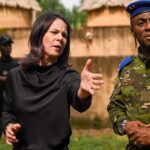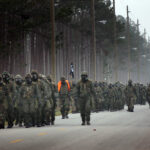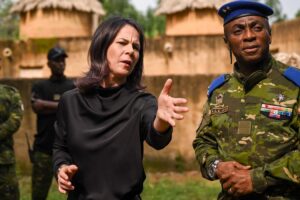In the 1950s, as the sun was setting on the British Empire and the winds of freedom were blowing across the African continent, a shop owned by Indian merchant Narain Bhagga on Livingstone Road (now Cha Cha Cha Road) in central Lusaka became a focal point in the Zambian independence struggle. A host of freedom fighters would meet at the shop, among them Kenneth Kaunda, who went on to become independent Zambia’s first president and was called “Africa’s Gandhi”.
It was in these meetings that the cultural and political gap between indigenous Africans and Indian immigrants from Gujarat, was bridged. In an article in World Affairs: The Journal of International Issues, academic Kamini Krishna named more than 10 prominent Indians who were involved in the Zambian freedom movement. One of them was Rambhai Levabhai Patel, a businessman who would go on to become a national icon in Zambia. Another was Chunibhai Patel, who was the general secretary of the Associated Chamber of Commerce and an associate member of the African National Congress. (Indians, at that time, were only allowed to be associate members of the party.)
Kaunda, who was the secretary of the African National Congress in Rhodesia, began to rely on the advice of Indian businessmen, who helped finance the Zambian freedom movement. In 1961, Kaunda launched a Gandhian civil disobedience movement called the Cha Cha Cha movement, named after the popular Cuban song and dance. The idea was for the British to “face the music” of Zambian independence. From being seen as collaborators of European colonists to becoming an important part of the freedom struggle, Indians came a long way in the country.
Indian migration
Unlike many parts of the world, such as Fiji, Mauritius and the Caribbean, Rhodesia (modern-day Zambia and Zimbabwe) did not witness the migration of Indian indentured labour. Those who did migrate to the region were classified as “passenger” Indians.
“All Indians in Central Africa, with few and unimportant exceptions, are Gujarati-speaking and come from a narrow strip of western India lying between Bombay and Ahmedabad, a distance of only 300 miles,” Floyd and Lillian Dotson wrote in their 1968 book titled The Indian Minority of Zambia, Rhodesia and Malawi. “All come from a fairly narrow sector of the total spectrum of class and caste represented even in this small region. Broadly speaking, neither the very top, nor the very bottom emigrated. Occupationally, virtually all Indians in Central Africa are in commerce, and the general level of education and sophistication is fairly high.”
Named Rhodesia after the controversial British mining magnate and politician Cecil Rhodes, the territory was divided into Southern and Northern Rhodesia along the Zambezi River and was a popular destination for settler colonialists from Britain.
The Indian National Archives contain several documents that show how colonial authorities in Rhodesia implemented measures to restrict Indian migration to the Central African colonies. This was often met with resistance by those governing British India. In the end, a small number of Indians migrated to Northern and Southern Rhodesia.
Indians began moving to Northern Rhodesia, that is Zambia, in the early 1900s. The European trading companies that dominated the colony resented the prospect of competition, but the colonial authorities allowed the Indians to stay after clearing a literacy test in a European language.
Within Zambia, they faced discrimination from European-origin settlers. “Here the European population contained many Afrikaner farmers, Jewish traders and a sizable working class made up of railway men and miners,” the Dotsons wrote. “Such people inevitably brought with them the anti-Indian prejudices common to South Africa at that time.”
By the time the freedom movement gained steam in Zambia, Indians enjoyed certain privileges that placed them on a standing higher than indigenous Africans but lower than Europeans.
Although many members of the community, which numbered a few thousand in the 1950s, preferred to live under the colonial structure, attitudes gradually changed with influential Indians taking on the Europeans and encouraging African freedom fighters.
“The rise of African nationalism has obscured the historical fact that it was Indians, not Africans, who first challenged the European-standards rule in British-occupied Africa,” the Dostons added.
Special friendship
Over the course of the meetings at Cha Cha Cha Road in the 1950s, Kaunda developed a close friendship with Rambhai Patel. This was a relationship that would play a key role in the Cha Cha Cha movement and the eventual attainment of Zambian independence.
“I was first introduced in a serious way to the ideas of Gandhi by Rambhai Patel, a Lusaka storekeeper, who made rough and ready translations of some of the Mahatma’s writings, especially passages from his life story,” Kuanda wrote in his book titled Kuanda on Violence. “I in turn fed these ideas into my earliest political speeches where, it seems to me now, they shone like gems in a river of mud.”
Calling the translations a “noble gesture”, Kaunda added that he was penniless at that time and was supporting a young family, but Patel backed him and the movement financially.
“Of course my friend Patel has always insisted that the help he gave me was an investment in Zambia’s future,” Kaunda wrote. “He thought it wise to spot winners amongst the young hopefuls jostling one another near the top of the heap in the infant nationalist movement.”
Patel, who was given the nickname Kanjombe, was around the same age as Kaunda and the two seemed to share a sense of humour. Talking about Patel’s contribution to the peaceful Zambian freedom movement, Kaunda added: “He might even say it was an act of self-preservation for if, as seemed likely, Central Africa was to go up in flames, he was one of those with most to lose – so he saw to it that the case for non-violence, Gandhi’s doctrine of satyagraha, was firmly implanted in the minds of those he guessed might be future leaders. It was Rambhai’s joke – for all his sardonic humour he was a deadly serious disciple of Mahatma Gandhi.”
Patel arranged for Kaunda to visit India for the first time in 1958. Led by Jawaharlal Nehru, India at the time was seen as an inspiration for African countries that were fighting off colonialism.
Kaunda, who would later be a state guest of India and remain one of its closest allies in Africa, wrote, “I owe Rambhai Patel much and can see why Jesus made a shrewd businessman the hero of one of his parables of his kingdom.”
Achieving independence
In 1953, the British merged Northern and Southern Rhodesia, along with Nyasaland, now Malawi, to form the Central African Federation. Kaunda, who became politically active in the same year, was imprisoned twice in the 1950s. In January 1960, after serving his second sentence, he became the president of the United National Independence Party, which was formed by those who quit the African National Congress.
The Zambian freedom fighters had initially focused on greater representation of Africans in governance. By the early 1960s, it became clear to the British that they would not be able to hold on to the entire Central African Federation. As a result of political negotiations, it was decided to separate Northern Rhodesia from the federation, which was eventually dissolved.
The civil disobedience of the Cha Cha Cha movement created a major headache for the British colonial authorities, who realised it was futile to hold on to Northern Rhodesia. In the 1964 elections, based on universal adult suffrage, the United National Independence Party won a majority and Luanda became the prime minister. Zambia attained independence on October 24, 1964, and Kaunda became its first president, keeping the post for the next 27 years.
The fact that Gujarati businessmen bankrolled the freedom movement was appreciated in the country, which invited Indian teachers, professionals and businesspeople to come and live there. Rambhai Patel’s businesses thrived in independent Zambia, as did those of other Indians who backed the freedom struggle.
When Kaunda died at the age of 97 in 2021, the Indian government paid rich tributes to the leader who had visited the country 10 times. The respect and admiration were always mutual. In his book, Kaunda wrote, “A free and independent India was the first and greatest of the nations of the so-called Third World. She was the Mecca or Jerusalem towards which weary freedom fighters on other continents turned for inspiration when things were going badly for them.”
Several decades after African countries attained independence, the goodwill that India generated in the continent has gradually faded. Now, with the Indian government making a renewed push to develop ties, it is essential that historical links like those with Zambia are celebrated.
Source: Scroll.in











